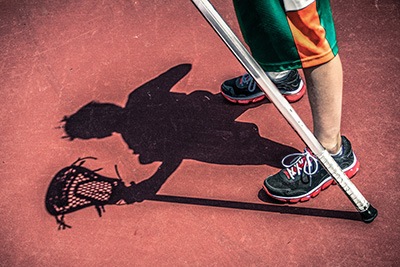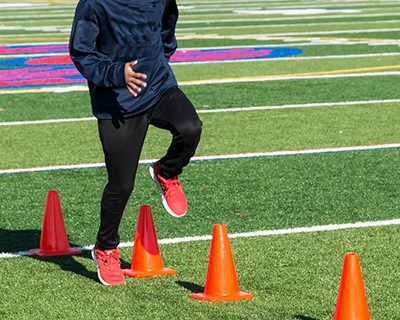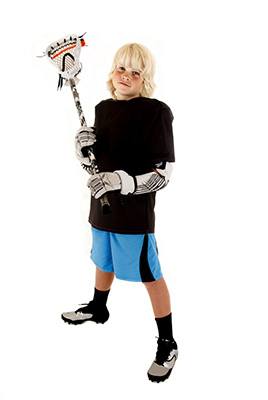Have you ever wondered how are lacrosse cleats different from other sports shoes? They may look similar, but they have some significant differences that make them great for the fast-paced, high-impact game of lacrosse.
This article will explore the components that make lacrosse cleats stand out from other sports shoes and explain why these unique features are important.
More...
Take Away Key Points:
Overview of Lacrosse Shoes
Lacrosse cleats are an essential piece of equipment for any lacrosse player. They typically have softer rubber soles than traditional soccer or football cleats but are much more durable and sturdy than running shoes.
Many lacrosse cleats feature a slightly narrower toe box to increase maneuverability and help players keep their footing during quick turns.
Lacrosse cleats also offer extra protection around the ankle to prevent injuries common in this fast-paced sport. Their primary purpose is to provide traction along the playing lacrosse surface, so your feet won't slip when making sharp turns. Additionally, they can give you extra stability and balance when taking quick shots on goal or participating in other high-energy activities.
Regular shoes for lacrosse are designed with four studies around the heel and six studs in the toe area.
Many cleats used for lacrosse are made from carbon fiber, leather, and polyurethane. Carbon fiber is often found in the plate inserts and the sole of shoes.
Lacrosse cleats are specifically designed with comfort and performance in mind while helping athletes reduce their risk of injury, making them an essential part of any lacrosse player's wardrobe.

Types of Lacrosse Cleats
Lacrosse players have a variety of sports cleats to choose from, depending on their playing lacrosse style and position. The most popular types of cleats are low-cut, mid-cut, and high-cut.
Lacrosse cleats vs. Football cleats
1. Design
Lacrosse sports cleats tend to have longer blades or studs that provide more traction on the field. They also often feature a wider base for better balance during quick and sharp cuts and turns and lightweight construction for faster speed without added weight.
On the other hand, football shoes are made with shorter blades and a greater focus on running and cutting motions. Football cleats also typically have stiffer midsoles that provide less flexibility during play. Additionally, these cleats have hard plastic spikes on tops so they can move quickly.
2. Use
Lacrosse players typically prefer cleats with shorter, more dense studs - such as those made of rubber - since the game is often centered around passing, dribbling, and quick changes in direction.
By contrast, longer metal cleats provide more grips between the feet and the ground and better traction, which is ideal for footballers that have to shift quickly and run at speed while also looking to tackle opponents.
For extra support and protection, lacrosse players often favor a wider fit within their stellar cleats to account for any ankle movements during games. Additionally, you can expect good ankle support as well.
3. Maintenance
Football cleats are more heavy-duty, padded, and structured for sturdy traction on harder playing fields like dirt and turf.
When it comes to maintenance, higher quality lacrosse cleats can stand up to months of wear without requiring much upkeep other than occasional cleanings.
However, football metal cleats need replacing every few weeks or so due to the harsher conditions they're exposed to.
4. Price
Soccer cleats are usually the least expensive, while lacrosse and football cleats tend to be more expensive. This price difference is due to factors such as material and level of protection needed.
Lacrosse cleats vs. Soccer cleats
1. Design
Lacrosse and soccer have a variety of cleats to choose from based on personal preference and style. However, the cleats for these two sports have distinct design differences. Lacrosse cleats contain more padding around the ankle for increased protection and ankle support when jumping for a high ball.
Soccer cleats are designed with thin synthetic cleat materials that provide support without the bulk of additional padding. The outsoles of lacrosse and soccer cleats are also designed differently to help with agility while playing the respective sport.
Lacrosse cleat outsoles often feature longer and deeper cleat tips, which help players grip the turf in various conditions.
Soccer cleats outsoles tend to have shallower plastic studs built to accelerate the speed and enhance traction when changing direction quickly during play.
Additionally, plastic cleats have fewer spikes, while plastic material spikes are mainly suitable for indoor lacrosse.
2. Use
The layouts of shallower cleats for soccer and lacrosse cleats are also quite different.
In contrast, soccer cleats offer more ventilation for improved breathability on the field, as lacrosse cleats provide a stable base for better support during quick movements.
Finally, lacrosse tends to be played on a turf field or grass. At the same time, soccer games are usually held on grass-covered outdoor fields, necessitating further adaptations in soles and outsole designs between the two sports.

3. Maintenance
Soccer cleats require different care, as they may need more traction on the field, so regular replacement is necessary (every 3-4 months), regardless of whether the sole is still intact.
Those who wear soccer cleats must wash them off after every practice or game using warm water and mild soap, then air them out to dry thoroughly before storage.
4. Price
Lacrosse cleats are typically more expensive than soccer cleats due to their design - they need to be lightweight and provide ample ankle height and support to withstand players' intense lateral movements during the game.
Lacrosse cleats vs. Baseball cleats
1. Design
While both cleats provide athletes with the grip and support needed to propel them on their fields, each type of the most versatile cleat is engineered with different objectives in mind.
Baseball cleats have low-to-mid cuts for better mobility, coupled with spikes or rubber soles explicitly made to allow players to dig into dirt or turf basepaths. In addition, the toe spike in baseball shoes is designed for higher jumps.
Furthermore, lacrosse cleats often have leather uppers and foam cushioning, while baseball cleats may include synthetic leather or mesh materials to increase breathability.
These key differences in construction highlight the fact that designers have tailored these shoes to accommodate the distinct needs of both sports.
2. Use
Lacrosse cleats are often smaller and lower to the ground than baseball cleats, with spikes that are less likely to get caught in the turf.
Some baseball cleats have a toe protector, which can be dangerous for lacrosse players since it increases the risk of head injuries.
3. Maintenance
Lacrosse cleats require frequent and thorough cleaning with a brush and soapy water after each time on the field. This helps preserve the high-quality leather and prevent the build-up of harmful dirt, ensuring that your boots remain comfortable and supportive for as long as possible.
On the other hand, baseball cleats can be wiped down with a damp cloth after each game, making them much easier to care for than lacrosse cleats.
4. Price
On average, lacrosse cleats can range from $28-$100 depending on style and material, whereas a good pair of baseball cleats usually start at $60.
FAQs
What is special about lacrosse cleats?
Lacrosse cleats are designed with unique features that enhance players' performance and protection on the field. For example, most lacrosse cleats come with strategically placed studs or cleats to ensure a better grip on grass or artificial turf.
Overall, lacrosse cleats are designed to maximize your game performance and safety!
Is it OK to wear lacrosse cleats for football?
While lacrosse cleats can offer good grip, comfort, and stability on natural and artificial surfaces, they are not designed for the heavier contact typical of football.
Football and lacrosse cleats have several key differences in design and material that help protect players from injury.
Additionally, you cannot wear baseball cleats and lacrosse shoes with a toe cleat in soccer or football.

Can lacrosse cleats be used for softball?
It is possible to use lacrosse cleats for softball, although it is usually not recommended.
Lacrosse cleats have small studs or cleats designed for the lighter contact that occurs in lacrosse and may not provide enough grip and support for the faster movements involved in softball.
What are lacrosse shoes?
Lacrosse turf shoes are specialized footwear explicitly designed for the sport of lacrosse. They are usually lightweight, with a low-profile fit and cushioning to provide maximum agility and comfort during play.
Lacrosse shoes often feature small cleats or treads on the bottom for added traction on natural or artificial turf surfaces.
What cleats do lacrosse players wear?
Lacrosse players wear cleats specifically designed for the sport, typically featuring small multi-directional studs or cleats on the bottom.
How should lacrosse cleats fit?
Lacrosse cleats should fit snugly without being too tight. Measure your foot from heel to toe and look for lacrosse shoes slightly longer than your actual foot size.
The cleats should also have a generous amount of room in the toe box, which allows your toes to spread out comfortably during play.
Are lacrosse cleats the same as soccer cleats?
No, lacrosse cleats are not the same as soccer cleats.
Soccer cleats typically feature longer and thicker studs, providing increased traction on grassy fields.
Lacrosse cleats have shorter, stubbier cleats or small multi-directional studs that give players a better grip when running and changing directions on turf or other playing surfaces.
Conclusion
At the end of the day, lacrosse cleats should fit comfortably and provide the necessary support and stability to help you perform your best. Make sure to measure your foot and look for a shoe with a generous toe box.
If you choose wisely, you'll find that wearing the right pair of lacrosse cleats can significantly improve your game.
